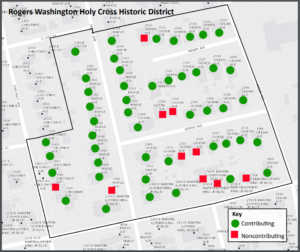East Austin historic district application receives support from Historic Landmark Commission
Monday, August 3, 2020 by
Jessi Devenyns Austin is well on its way to getting its second historic district on the east side. The Rogers-Washington-Holy Cross neighborhood, which is roughly bounded by East 21st Street and East Martin Luther King Jr. Boulevard between Cedar and Chestnut avenues, submitted an application to the city for consideration as a historic district. In the application’s first stop before the Historic Landmark Commission on July 27, the body unanimously recommended the application for approval.
“We’re saying (the neighborhood’s) value to us as a community transcends what a developer thinks is the highest and best use,” Commissioner Witt Featherston said.
The East Austin neighborhood is a 57-home, postwar community built between 1953 and 1970 and served as the home of many of the city’s most influential Black residents. Although its history is more recent than many other local historic districts, the community has a notable past that is tied to educational leaders like Willie Mae Kirk, a teacher and a civil rights leader who fought against segregation in Austin, and political influencers like Jimmy Snell, the first Black mayor pro tem. Today many of the descendants of these influential figures still live in family homes.

Not only is the cultural fabric of the neighborhood still largely intact, it retains 82 percent of its contributing structures; city code requires that at least 51 percent of the structures within a proposed district contribute to its historic character.
The effort to compose an application for a historic district was driven by the neighbors themselves and received support from 63 percent of the homeowners within the defined boundaries.
“We’ve worked to make sure that everyone in our neighborhood had a voice in the process,” Brenda Malik, the neighborhood association president, told commissioners. She explained that the neighborhood association has worked since October 2017 to define and refine the design standards for the proposed district in a way that incorporated feedback from residents. Homeowners were invited to participate through dozens of meetings, emails and door-to-door contacts. The neighborhood association also tracked down homeowners who live out of state in order to include them in the process.
The application also had support from local organizations including Preservation Austin, which has supported the historic district design efforts for two years through grants, the Austin History Center, the Blackland Community Development Corporation and the city’s Equity Office.
“This neighborhood represents the strength and tenacity of many African American families who dedicated their lives to the education and uplifting of their children and their community,” Chief Equity Officer Brion Oaks said in a letter.
In addition to organizational endorsement, over a dozen residents from the neighborhood attended the Landmark Commission meeting to express their support for the historic district.
“So many things are changing – this particular moment must be seized to help preserve something that is vital to this city,” said resident Barry McBride, whose aunt taught at the original L.C. Anderson High School.
Connie Kirk, whose mother was Willie Mae Kirk and whose brother served as President Obama’s U.S. trade representative, said, “This is something you all can’t take from us, the history of the Blacks in East Austin.”
However, not all residents were supportive of the application. Taylor McDowell asked the commission to exclude his property from the historic district in its vote.
His property at 2011 Maple Ave. is along the northern border of the proposed district. “I don’t know why our property’s inclusion would be particularly important,” he said. “We would be unduly and disproportionally affected by the historic process.” He noted that having the ability to expand his home in the future is a “key economic factor for the appreciation of our property.”
In the proposed design standards, there are provisions allowing for accessory dwelling units. However, additions to a contributing building must receive a Certificate of Appropriateness from the Historic Preservation Office before any work may be done.
Malik told commissioners that the property at 2011 Maple Ave. belonged to the oldest resident in the neighborhood, who passed away last year at 105 years old and whose husband developed the majority of the neighborhood.
Commissioner Terri Myers said she was unwilling to gerrymander the boundaries outlined by the applicants. “Carving it out would be like cherry-picking, and that’s not recommended practice,” she said.
The unanimous vote in favor of the historic district application adds to the substantial amount of support that the district has received so far. The application will now move forward to the Planning Commission for consideration before going to City Council.
Photo and map courtesy of the city of Austin.
The Austin Monitor’s work is made possible by donations from the community. Though our reporting covers donors from time to time, we are careful to keep business and editorial efforts separate while maintaining transparency. A complete list of donors is available here, and our code of ethics is explained here.
You're a community leader
And we’re honored you look to us for serious, in-depth news. You know a strong community needs local and dedicated watchdog reporting. We’re here for you and that won’t change. Now will you take the powerful next step and support our nonprofit news organization?










